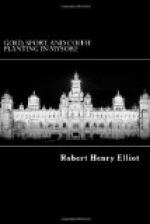the coast, and amidst the gorges of the Ghauts, with
vast heights towering upwards, and almost all around,
while the river, which had now sunk to what in English
ideas would still seem to be one of considerable size,
appeared as if it had just emerged from the navel
of a mountain-barrier some miles ahead. After
a few miles more we passed the last hamlet of what
was then called the Company’s Country, and leaving
the inhabited lands—if indeed in a European
sense they may be called so—behind us, began
to ascend the twenty miles of forest-clad gorges which
lead up into the tableland of Mysore. The ascent
was necessarily slow, and it was not till late in the
afternoon that I saw, some 500 feet above me, and at
a total elevation of about 3,200 feet above sea-level,
the white walls of the only planter’s bungalow
in the southern part of Mysore. To this pioneer
of our civilization—Mr. Frederick Green,
who had begun work in 1843—I had a letter
of introduction, and was most kindly received, and
put in the way of acquiring land which I started on
and still hold. To the south, in the adjacent
little province of Coorg—now, as we shall
afterwards see, an extensive coffee-field—the
first European plantation had been started the year
before, i.e., 1854, while to the north some fifty
to seventy miles away the country was, in a European
sense, occupied by only three English, or, to be exact,
Scotch planters. In 1856 I started active life
as a planter on my own account, about twelve miles
away from the estate of Mr. Green, while in the same
year two other planters—Scotchmen by the
way—made their appearance. The southern
part of Mysore was thus occupied by four planters,
and we were all about twelve miles from each other.
It is difficult to conceive the state of isolation
in which we lived, and as we were all Europeanly speaking
single handed, and could seldom leave home, we often
had not for weeks together an opportunity of seeing
a single white face, and so rare indeed was a visit
from a neighbour that, when one was coming to see
me, I used to sit on a hill watching for the first
glimpse of him, like a shipwrecked mariner on a desert
island watching for the glimpse of a sail on the horizon.
As for the Indian mutinies, which broke out the year
after I had started work, they might have been going
on in Norway as far as we were concerned; none of us
at all appreciated the importance and gravity of the
events that were occurring, and one of my neighbours
said that it was not worth while trying to understand
the situation, and that we had better wait for the
book that would be sure to come out when things had
settled down. And the native population around
us appeared to know as little of the mutinies as we
did. They seemed to be aware that some disturbance
was going on somewhere in the north, and that represented
the whole extent of their knowledge of the subject.




